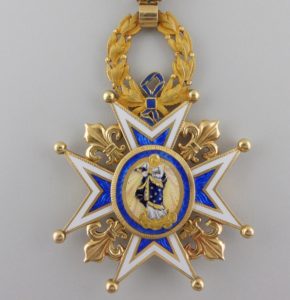
Cross of Commander of the Order of Charles II of Spain. Image credit: Emedals.com
Antoine Imbert-Gourbeyre de la Touche M.D. (2 March 1818 – 6 March 1912) was a French orthodox physician and Professor of Therapeutics and Materia Medica at the Medical School of Clermont Ferrand, who converted to homeopathy, to become President of the International Homeopathic Congress in Paris in 1867.
Imbert-Gourbeyre first began to investigate homeopathy in order to refute it, but his studies convinced him instead to convert to homeopathy.
Imbert-Gourbeyre was a colleague of Jose Nunez Pernia Marquis de Nunez, the honorary President of the 1867 Paris Congress.
Antoine Imbert-Gourbeyre was a student of Jean Paul Tessier and followed his tutor in converting to homeopathy. Between 1852 – 1888 Imbert-Gourbeyre was professor at the Clermont School of Medicine:
Being more worldly wise than his fellow students, Davaine, Frédault, Ozanam and Jousset, he waited until he had been appointed to the professorial chair at Clermont-Ferrand before declaring himself.
In 1854 and again in 1860 he was awarded the Laureate of the Imperial Academy of Medicine.
In 1865 Imbert-Gourbeyre was made a Commander of the Royal Order of Charles III of Spain.
In the winter of 1867-8 Imbert-Gourbeyre also privately practiced in Nice.
As with many of his homeopathic colleagues, Imbert-Gourbeyre endured the prejudice of orthodox medical men. It was recorded that the Rhône Medical Society had decided that those members who used homeopathy be dismissed from the Society:
According to this decision Prof. Dr. Imbert Gourbeyre de la Touche (1818-1912), Prof. at the Clermont Ferrand University, was excluded from the Rhone Medical Society in 1887. After this case was reported to a wide public, the theatre critic Francisque Sarcey strongly criticized the absurdity of Society’s decision, recalling the medical staff of “The imaginary sick” by Molière. In reply, he was advised by the Society’s newspaper La Province Médicale (August 20, 1887) to judge only those matters he has studied; as to the expulsion of a member, the newspaper explained that the Rhône Society had considered that no physician can become a homeopath if he has not lost either his mind or his conscience.
In addition to his role at Clermont and his work in private practice, Imbert-Gourbeyre was also an active researcher:
Imbert Gourbeyre, who has made Arsenic an almost life long study, and to whom we owe so much knowledge regarding it, has studied this branch of its action in his Suites de L’Empoisonnement Arsenical lately (1880) published in L’Arte Médicale.
Towards the end of the nineteenth century Imbert-Gourbeyre investigated the phenomena of religious stigmata and other miracles reported at Lourdes. He identified hundreds of cases of stigmata that had occurred up to that time. His findings were published in his two-volume 1894 medical study, La Stigmatisation: L’Extase Divine et les Miracles de Lourdes, Réponse Aux Libres-Penseurs.
Imbert-Gourbeyre was a prolific writer and in addition to his many published books he also submitted cases and articles to various homeopathic publications, and he gave many public lectures on homeopathy, and conducted many provings of homeopathic remedies.
Select Publications:
- Contractures des Extrémités (1844)
- Mémoire sur les Propriétés Antinévralgiques de L’Aconit (1854)
- Mémoire sur L’Éphidrose (Sueurs Générales Chroniques) (1855)
- De l’Albuminurie Puerpérale et de ses Rapports Avec L’Éclampsie (1856)
- Mémoire sur le Prurit Vulvaire, sur Celui de la Grossesse en Particulier (1857)
- Éloge Historique de J. B. Achard-Lavort (1858)
- Etudes sur la Paralysie Arsenicale (1858)
- Mémoire sur L’Hypertrophie Aiguë du Coeur (1858)
- Éloge de Michel Bertrand, lu à l’Académie des Sciences, Belles-Lettres et Arts de Clermont, lu le 8 Novembre 1860 (1861)
- Mémoire sur les Éruptions Antimoniales (1861)
- Recherches Historiques sur les Paralysies Consécutives aux Maladies Aiguës (1862)
- Titres et Travaux Scientifiques (1863)
- Lectures Publiques sur L’Homoeopathie (1865)
- Leçons sur le Tabac: Faites au Palais des Fácultés de Clermont-Ferrand (1866)
- Mémoire sur L’Ipécacuanha (1869)
- De L’Action de L’Arsenic sur la Peau (1871)
- Les Stigmatisées I: Louise Lateau de Bois-D’Haine (1873)
- Les Stigmatisées II: Palma D’Oria (1873)
- De la Mort de Socrate par la Ciguë, Ou Recherches Botaniques, Philologiques, Historiques, Physiologiques et Thérapeutiques sur Cette Plante, (1875)
- Memoir on Arnica, Addressed to the World’s Homoeopathic Convention at Philadelphia (1879)
- Des Suites de L’Empoissonnement Arsenical (1880)
- Recherches sur les Aolanum des Anciens (1884)
- Discours sur le Origines Chrétiennes de la Médecine (1886)
- Der Glaube und die Medizinische Wissenschaft: Ein Vortrag (1888)
- Histoire de L’Aconit (1894)
- La Stigmatisation: L’Extase Divine et les Miracles de Lourdes, Réponse Aux Libres-Penseurs I: Les Faits (1894)
- La Stigmatisation: L’Extase Divine et les Miracles de Lourdes, Réponse Aux Libres-Penseurs II: Analyse et Discussion (1894)
- L’Hypnotisme et la Stigmatisation (1899)


Does anyone have any biographical information about Dr. Imbert-Goubeyre other than what has been posted by Sue Young and what can be gleaned from the extensive literature pertaining to his writings and career now available on the internet? I am assisting my wife in a scholarly study of his ideas in the context of 19th century religious and intellectual history, and we are especially interested in information about his background and his earlier life and family. – Paul Zimdars-Swartz, Instructor, The University of Kansas.
Passionné par les travaux du docteur Imbert, je suis en train de reconstituer son ascendance!
mais je serais heureux d’avoir tous renseignements sur la date et le lieu de sa mort, et s’il s’est marie et a eu des enfants!
Bien cordialement!
Antoine Imbert est né à Riom le 2 mars 1818 et est décédé le 6 mars 1912.
Il était l’époux de Sophie Giraud dont il a eu quatre enfants :
Marc Marie Ignace,
Marie Antoinette,
Jules Clément
et enfin Delphine Eugénie
Translated:
Antoine Imbert was born in Riom on 2 March 1818 and died on 6 March 1912.
He was the husband of Sophie Giraud of which he had four children:
Marc Marie Ignace,
Marie Antoinette,
Jules Clément
And finally Delphine Eugénie